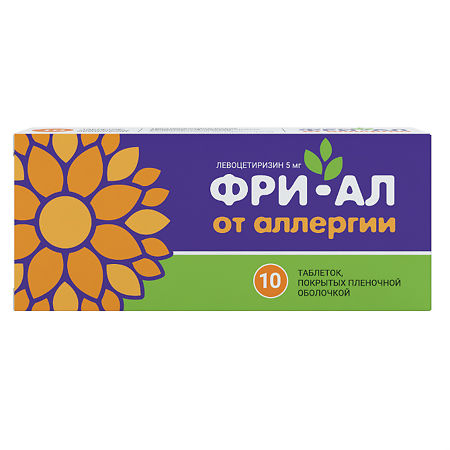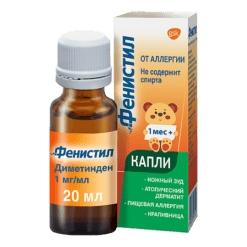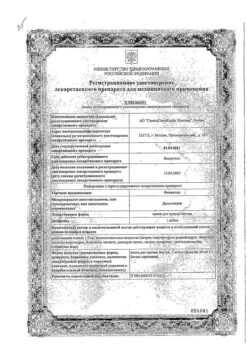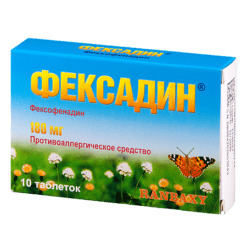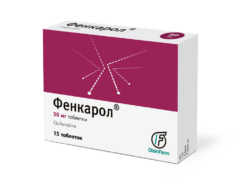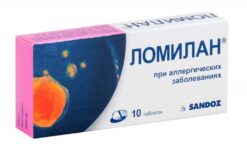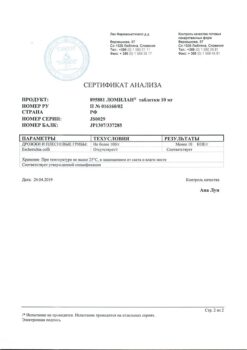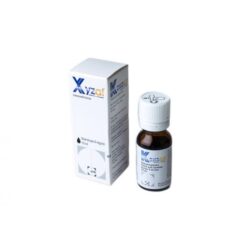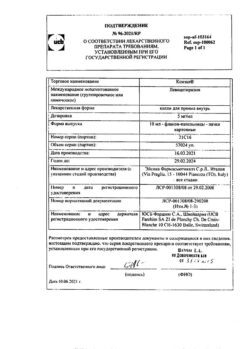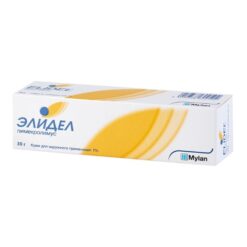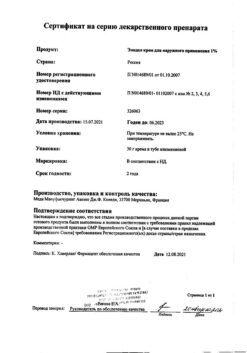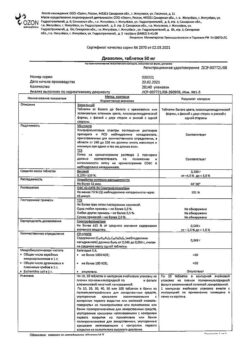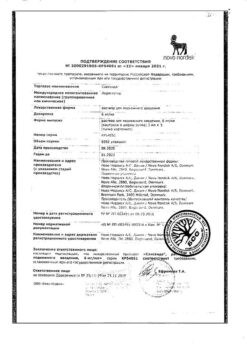No products in the cart.
Description
Pharmacotherapeutic group:
Anti-allergic agent – H1-histamine receptor blocker
ATC:
R.06.A.E.A.E Piperazine derivatives
R.06.A.E.09 Levocetirizine
Pharmacodynamics:
Levocetirizine is the R enantiomer of cetirizine; a competitive histamine antagonist; blocks H1-histamine receptors, which have twice the affinity of cetirizine. Levocetirizine affects the histamine-dependent stage of allergic reactions; it reduces the migration of eosinophils, reduces vascular permeability, and limits the release of inflammatory mediators. It prevents and facilitates the development of allergic reactions, has antiexudative, antipruritic effects; it has practically no anticholinergic and antiserotonin action. In therapeutic doses has almost no sedative effect.
Pharmacokinetics:
The pharmacokinetic parameters of levocetirizine change linearly with dose and are virtually identical to those of cetirizine.
Absorption: Quickly and completely absorbed when ingested. Food intake has no effect on the completeness of absorption, but reduces its rate. Maximal concentration (Cmax) in blood plasma is reached after 0.9 hour and is 270 ng/ml. The constant level of drug concentration is reached after two days of use.
Distribution: Binding to plasma proteins is 90%. Volume of distribution (Vd) is 0.4 l/kg. Bioavailability reaches 100%. It penetrates into the breast milk.
Metabolism: Less than 14% of the drug is metabolized in the liver by N- and O-dealkylation to form pharmacologically inactive metabolite. Due to the low level of metabolism and lack of metabolic potential (the cytochrome system is minimally involved in its metabolism) interaction of levocetirizine with other drugs seems unlikely.
Elimination: In adults, the T1/2 (elimination half-life) is 7.9 ± 1.9 h and total clearance is 0.63 ml/min/kg, in young children the T1/2 is shorter. About 85.4% of the administered dose of the drug is excreted by the kidneys, about 12.9% – through the intestine.
Particular groups:
Patients with renal impairment
In renal impairment (creatinine clearance (CK) < 40 ml/min), clearance is decreased (in patients on hemodialysis by 80%) and T1/2 is prolonged. Less than 10% of levocetirizine is removed during a standard 4-hour hemodialysis procedure.
Children
The data from a study of the pharmacokinetics of the drug in 14 children aged 6 to 11 years with a body weight of 20 to 40 kg when 5 mg of levocetirizine was taken orally once showed that the Cmax and area under the curve (AUC) were approximately twice that of healthy adults in a cross-match control.
The data from the analysis showed that administration of the drug at a dose of 1.25 mg in children aged 6 months to 5 years resulted in plasma concentrations consistent with those in adults when 5 mg of the drug was taken once daily.
Elderly patients
There are limited data on pharmacokinetics in elderly patients. When 30 mg of levocetirizine was repeatedly administered once daily for 6 days in 9 elderly patients (age 65 to 74 years), total clearance was approximately 33% lower than that of younger adults. The distribution of cetirizine racemate has been shown to be more dependent on renal function than on age. This statement may also be applicable to levocetirizine, since both levocetirizine and cetirizine are primarily excreted with the urine. Therefore, in elderly patients, the dose of levocetirizine should be adjusted depending on renal function.
Indications
Indications
– Treatment of symptoms of year-round (persistent) and seasonal (intermittent) allergic rhinitis and allergic conjunctivitis, such as itching, sneezing, nasal congestion, rhinorrhea, lacrimation, conjunctival hyperemia;
– pollinosis (hay fever);
– urticaria;
– other allergic dermatoses accompanied by itching and rashes.
If necessary, please consult a physician before using the medication.
Active ingredient
Active ingredient
Composition
Composition
One tablet contains:
the active ingredient:
levocetirizine dihydrochloride – 5.0 mg;
excipients:
Microcrystalline cellulose – 53.2 mg,
croscarmellose sodium – 3.8 mg,
Pregelatinized starch – 32.04 mg,
colloidal silicon dioxide – 0.48 mg,
magnesium stearate – 0.48 mg;
Pill coating:
Opadray II white – 3.8 mg (lactose monohydrate – 1.37 mg, hypromellose – 1.06 mg, titanium dioxide – 0.99 mg, macrogol 3000 – 0.38 mg).
How to take, the dosage
How to take, the dosage
The drug is taken orally with meals or on an empty stomach, without chewing, with a small amount of water. It is recommended to take the daily dose in 1 dose.
Adults and children over 6 years of age: The daily dose is 5 mg. The maximum daily dose is 5 mg.
Children under 6 years of age are not prescribed tablets: a different, liquid dosage form is used for them.
Because levocetirizine is excreted by the kidneys, the dose should be adjusted according to creatinine clearance if the drug is prescribed in patients with renal impairment and elderly patients.
In patients with renal and hepatic impairment, the dosing is according to the table above.
If only hepatic function is impaired, no dosing adjustment is necessary.
When treating seasonal (intermittent) rhinitis (presence of symptoms less than 4 days per week or their total duration less than 4 weeks), the duration of treatment depends on the duration of symptoms: treatment may be stopped when symptoms disappear and resumed when symptoms appear.
When treating year-round (persistent) allergic rhinitis (presence of symptoms more than 4 days per week and their total duration of more than 4 weeks), treatment may continue for the duration of allergen exposure.
There is clinical experience of continuous use of Levocetirizine in the dosage form of film-coated tablets 5 mg in adult patients for up to 6 months.
The drug should only be used according to the route of administration and in the doses mentioned in the leaflet.
If you forget to take the medication, do not take a double dose to make up for a missed dose, take the next dose at the usual time.
If there is no improvement after treatment or if new symptoms appear, you should consult your doctor.
Interaction
Interaction
The study of interaction of levocetirizine with other drugs has not been conducted.
In the study of drug interactions of cetirizine racemate with antipyrine, pseudoephedrine, cimetidine, ketoconazole, erythromycin, azithromycin, glipizide and diazepam no clinically significant adverse interactions were found.
Concomitant use with theophylline (400 mg/day) decreases total clearance of cetirizine by 16% (the kinetics of theophylline is not changed).
When ritanovir (600 mg twice daily) and cetirizine (10 mg daily) were used concomitantly, the study showed that cetirizine exposure was increased by 40% and ritanovir exposure was not significantly altered (-11%).
In some cases, concomitant use of levocetirizine with alcohol or medications that have an inhibitory effect on the central nervous system (CNS) may cause lethargy and impaired performance.
Special Instructions
Special Instructions
Dose intervals should be chosen individually depending on renal function.
At the time of treatment it is recommended to refrain from drinking ethanol (alcohol).
Levocetirizine tablets contain lactose monohydrate; therefore, they should not be prescribed in patients with lactose intolerance, hereditary lactase deficiency or glucose-galactose malabsorption syndrome.
Patients with predisposing factors to urinary retention (e.g., spinal cord injury, prostatic hyperplasia) should exercise caution because levocetirizine may increase the risk of urinary retention.
Impact on the ability to drive:
Levocetirizine may lead to increased drowsiness; therefore, the drug may affect the ability to drive or operate machinery. During the period of using Levocetirizine it is reasonable to refrain from performing potentially hazardous activities requiring increased concentration and quick psychomotor reaction (including driving and operating machinery).
Contraindications
Contraindications
– Hypersensitivity to the active substance, cetirizine, hydroxyzine, any piperazine derivative or any other excipient of the drug;
– lactase deficiency, lactose intolerance, glucose-galactose malabsorption;
– end-stage renal failure (creatinine clearance less than 10 ml/min);
– children under 6 years of age (for tablets, due to limited data on efficacy and safety).
With caution:
Caution is required in the following conditions: chronic renal insufficiency (dosing regimen must be adjusted); in elderly patients (with age-related decreased glomerular filtration), concomitant use with alcohol (see concomitant use of alcohol (see also section “Interaction with other medicinal products”); in patients with spinal cord injury, prostatic hyperplasia and in the presence of other predisposing factors to urinary retention, since levocetirizine may increase the risk of urinary retention; when administered to pregnant women and during breast-feeding.
Side effects
Side effects
The frequency of side effects is unknown (cannot be estimated from the available data).
Immune system disorders: hypersensitivity reactions, including anaphylaxis.
Metabolic and nutritional disorders: increase in appetite.
Psychiatric disorders: anxiety, aggression, agitation, depression, hallucinations, insomnia, suicidal thoughts.
Nervous system disorders: seizures, dura sinus thrombosis, paresthesia, dizziness, fainting, tremor, dysgeusia.
Hearing: vertigo
VIight: visual impairment, blurred vision, inflammatory manifestations.
Cardiovascular system: angina, tachycardia, palpitations, jugular vein thrombosis.
Respiratory system: dyspnea, increased symptoms of rhinitis.
In the digestive system: nausea, vomiting, diarrhea.
Hepatobiliary disorders: hepatitis, changes in liver function tests.
Renal and urinary system disorders: dysuria, urinary retention.
Skin and soft tissue disorders: angioedema, persistent erythema drug, itching, rash, urticaria, hypotrichosis, cracks, photosensitization.
Muscular system disorders: muscle pain, arthralgia.
General disorders: peripheral edema, weight gain.
Other: cross reactivity.
If any of the side effects listed in the instructions worsen, or if you notice any other side effects not listed in the instructions, tell your doctor.
Overdose
Overdose
Symptoms of overdose: drowsiness (in adults), agitation and restlessness, followed by drowsiness (in children).
The treatment of overdose: immediately after ingestion it is necessary to flush the stomach or induce vomiting. Symptomatic and supportive therapy is recommended. There is no specific antidote. Hemodialysis is ineffective.
Similarities
Similarities
Additional information
| Shelf life | 3 years. |
|---|---|
| Conditions of storage | At a temperature not exceeding 25 ° C, in the original package. Store out of the reach of children. |
| Manufacturer | ALSI Pharma, Russia |
| Medication form | pills |
| Brand | ALSI Pharma |
Related products
Buy Fri-Al, 5 mg 10 pcs. with delivery to USA, UK, Europe and over 120 other countries.

